
:: SPANISH WORKING TESTS
Seraching test
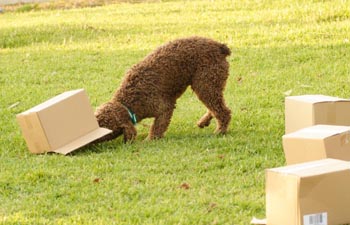
Kiko diving
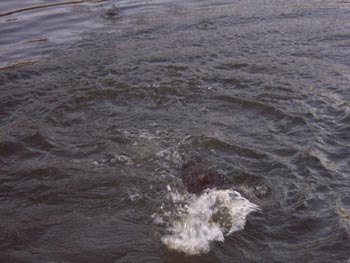
Kiko towing the surfboard
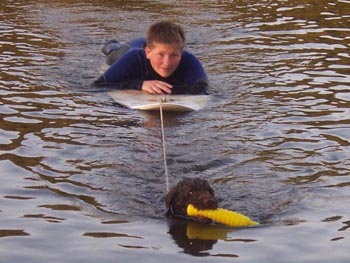
Neus waiting for water retrieve
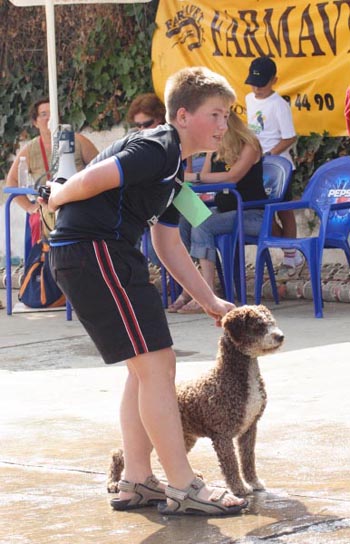
VIDA on the rampa working
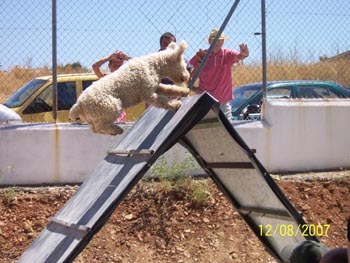
Neus on her way back
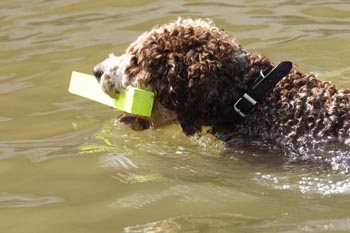
Kiko on the test of corage
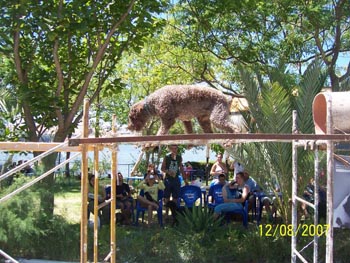
The World Working Championships are held in Arcos De La Frontera every August, and they are always very well attended. The aim of the championships is to get people involved with working their Spanish Water Dogs, in a way where they can all compete and have fun, whatever standard their dog may be at. Everybody is given great encouragement, and applauded for their efforts. You will see many friendly faces, and everyone enjoys a lovely lunch together. The bar is open all day too!
There are 7 tests, and your dog gets points for speed, obedience and presentation.
The tests basically are:
WATER WORK.
- Water retrieve from 20 meters, and timed.
- Retrieving the surfboard with a 60Kg child on top, from 20 meters, and timed.
- Diving at depths of 50cm and 100cm. Then a decider of diving from a jetty to a depth of 1 meter.
LAND WORK.
- Land retrieval from a distance of 20 meters, timed
- Rampa, (similar to our A frame). Retrieve an object thrown over, by going over the rampa and then returning as quickly as possible.
- Searching for an object with your scent on, within an area and under 7 boxes.
- The test of courage is the ladders, tunnel, bed springs, planks and horizontal ladders, all at a height of approx 1.8 meters, and timed with penalties.
This is a super friendly event, recommended to anyone, no matter what your dog’s abilities are. The Spanish just want you to enjoy your dogs.
WORK TRIALS
RULES OF THE WORK TRIALS COMPETITION
Trials revised in the Technical-Practical Study Days and Development of Work Trials Specific to Spanish Water Dogs, which took place in Ubrique on the 29, 30 and 31 May, 2002.
Preliminary Considerations
Subscription to the trials requires entrants accept and abide by all the rules and regulations, with no exceptions. It will not be acceptable to claim that the organisers are responsible or have made a mistake.
Each and every trial may be repeated two times, with a maximum interval of five minutes between each attempt. The highest score of the two will be valid.
At the time of undertaking each trial, only the dog, its guide, the judges in charge of scoring the trial in question, and any other person authorised by the event organisers, will be allowed in the vicinity of the trial. This rule is intended to ensure that the trials are conducted without disturbances and the organisers will set in place a security zone which cannot be entered by any person who is not one of the organisers or authorised by them.
The participants, like the dogs for which they are responsible, can in no moment interfere, distract, or obstruct the trial for another participant. Following such an offence, the organisers, in consultation with the judges, may disqualify the guilty party, and invite them to withdraw from the trials.
Whenever there is any proof of infringement of the rules at any moment of the competition, the organisers can, through the judges of the different trials, disqualify a dog, and even its guide; if the organisers see fit, the latter will not be able to reenter the competition for working dogs with any other dog in the same trials.
In order to qualify for any kind of recognition by the organisers of the competition, be this in the form of a prize, qualifying point, certificate of aptitude for working, etc. the dogs must be obligatorily Water Dogs, understood as the swimming or diving kind. The final point score is the average score of all the scores.
For example, a dog that only enters three trials will add together all the points scored and divide the total by the number of trials entered, which in this case would be a minimum of three. If a dog has entered 4 trials, the final score is measured by adding together the four scores and dividing by four. The same method works up to the maximum number of trials a dog may enter.
The organisers reserve the right to modify or annul partially or totally each one of the existing trials at the time of the competition, as well as change the location of the trials.
Whether or not they are taking part in the competition, dogs should, at all times, be in the control of their masters (on leashes or in the back seat of cars). The owners are always directly responsible for any damage caused by their dogs, before, during or after the trials take place.
WORKING TRIALS FOR THE SPANISH WATER DOG
A) RETRIEVAL OF OBJECTS (FLOATING OBJECTS) IN THE WATER TRIAL
Distance: 20 metres
Trial description:
The object location: The object will already be located in the water, and the dog will be situated next to his guide in a zone marked out by a line 2 metres from the water's edge. The judge will give the order to undertake the exercise ("ready", "steady", "GO") and set the clock ticking. The entrance of the dog in the water can be either with a running jump or walking. If the dog does not find the roller ("el rodillo") in the water, the guide can orientate the dog by throwing a stone towards where the object is located for a maximum number of 3 times (3 stones). Each stone throwed incurs a 5 second time penalty which have to be added to the time taken in retrieving the object. The trial will end when the dog reenters the marked out zone. The guide is not allowed, under any circumstances, to step over the 2 metre line mark: the dog must find its own way back to its master. Any infringement will be penalised with a 10 second time penalty to be added to the total time elapsed.
This trial may be repeated a second time, and the shorter time will score.
BRIEF SKETCH
(There follows a brief sketch showing the water, a floating object, a marking out line 2 metres from the water's edge and two blocks representing the starting and ending position of dog and trainer.)
TIME AND SCORES
(There follows a table showing the scores for different times. The left hand columns designate time in seconds, the right hand columns show corresponding point scores.)
Second scores that are not multiples of five will be scored equivalently.
Example: 49 seconds is equivalent to 7.1 points, 48 to 7.2, 71 seconds is equivalent to 4.9 points, 72 to 4.8 points, etc.
Note: if the dog does not make the retrieval first time, only one more attempt will be made, and the points for the second attempt will be allotted. If the retrieval is not made on the second attempt, a 0 score will be obtained.
B) SEARCH AND RETRIEVAL FOR AN UNDERWATER OBJECT (DIVING)
This trial has the following modalities:
MODALITY A):
Depth 1 metre
MODALITY B):
Depth 0.5 metres
The water must be clear
The guide will throw the roller ("el rodillo") into the water and when it has sunk, will order the dog to retrieve it. Once the dog is in the water, and if the object has not been found, five attempts can be made to orientate the dog (throwing a small stone on the place where the submerged object is located). 0.5 points are knocked off for each attempted orientation on a maximum of 10 points for trial A ) and a maximum score of 5 points for trials B). The trial will only be valid if the retrieval is made.
Because of the special nature of this trial the competition jury can make mention of any dog who participates in it, independent of whether the retrieval is made or not, for the most number of immersions underwater, as well as for the length of time spent under the water.
C) SHIPWRECK SAVE AND RESCUE TRIAL
The dog will be located next to the guide in a zone marked out bvy a line 2 metres from the water's edge. This trial will consist of taking a manikin out of the water (a life-sized doll) on top of a surf board, weighing between 50 and 60 kilos, located at a distance of 20 metres.
The guide will be able to direct the dog by throwing a stone towards where the object is for a maximum of 3 attempts (3 stones). Every stone thrown will incur a 5 second time penalty which will be added to the total time taken to make the retrieval. This trial may be repeated a second time, and the shorter time will be scored.
TIME AND SCORING
As above.
D) WORK TRIAL FOR SAVE AND RESCUE IN A LAND DISASTER
The trial for rescue in a disaster situation consists in the following:
Section 1:
2.5m high stairs (resting 1.8m off the ground at its highest point).
Width of the steps: 7cm (upholstered with wooden board or other material that prevents sliding).
Width of the stairs: 50cm.
Number of steps: 5-8 approximately.
Section 2:
3 metre long by 20cm wide plank.
Section 3:
1.9 metre sprung bed case.
Section 4:
3 metre long tube, 30cm diameter.
Section 5:
Horizontally placed sheets measuring 1.9m long by 80cm wide, with a thickness of approximately 7cm for each sheet, separated from each other by about 30cm (similar to modern "bodyguard" sheeting in which one sheet is taken out and the other left).
Section 6:
Called "de ralles" (of lines) which consists of 2 planks 3 metres long by 10 cm wide, placed in parallel between them and with a gap of 15 cm between them.
Section 7:
Descent consisting in a stairway like the one described earlier or in a ramp 2.5 metres long by 20 cm wide.
TIME AND SCORING
(As above.)
BRIEF SKETCH
(shows the sections from above.)
PICTURE IN PROFILE
The time will begin when the judge gives the order to begin, and ends when the dog touches the ground with all four legs at the end of the exercise.
All the setup has to show stability, without extraneous movements or strange balances, so that it can resist the weight of a person.
E) CLIMBING AND JUMPING TRIAL
This will take place on a ramp shaped in the form of an equilateral triangle, each side measuring approximately 2.3 metres.
The dog will be placed 5 metres distance from the obstacle and will be ordered to climb and jump from the ramp.
It is permitted to place an incentive on top of the obstacle to encourage the dog to undertake the exercise.
3 attempts at the trial are permitted, with the following scores:
1st ATTEMPT: 6 points
2nd ATTEMPT: 4 points
3rd ATTEMPT: 2 points
F) OBJECT SEARCH TRIAL:
This trial consists in the search for an object in the shortest possible time.
The dog should remain with its back turned while the object is hidden. The object in question will be a tennis ball which the organisers will hand over 10 minutes before the trial to all the participants entered in this trial. The ball will be hidden by the judge of the trial in one of the five cardboard boxes which each test consists of.
A 50cm gap will separate the aforesaid boxes. The dog's guide will have to remain within a radius of 4 metres. He is not allowed to give any signal to the dog, apart from encouraging the dog to search. The boxes, made of cardboard, will be changed for each dog that takes part.
The participant dog may be disqualified before, during, or after the trial, if the judge has any reason to suspect that the ball has been tampered with.
TIME AND SCORING
(As before).
BRIEF SKETCH
(A sketch of the 4 m perimeter, with the five boxes at the top and the dog below. The guide is represented below the dog, outside the perimeter.)
G) HUMAN SEARCH
This trial consists in the search for a person who has earlier hidden in a place with trees or bushes that hide them from the vision of the dog, at a distance of approximately 80 metres.
The dog may be ordered to search by giving it an object to smell belonging to the person hiding, who under no circumstances can be the dog's guide. The guide cannot follow the dog or give any type of signal intended to help the dog in the search, except for general encouragement.
The trial will end when the dog finds the person in hiding, by giving notice of this by barking, or by another acoustic signal (whistle or horn) made by the person who has been found, always and only when this aforementioned person has been designated as such by the organisers.
TIME AND SCORES
(As above.)
|